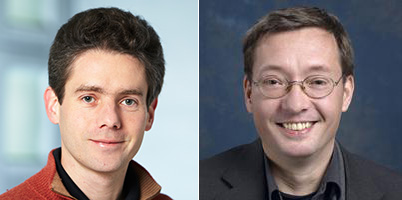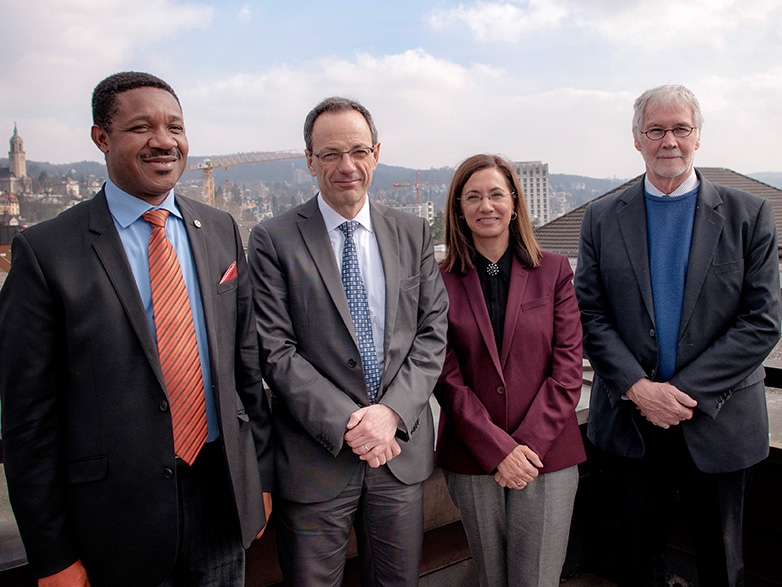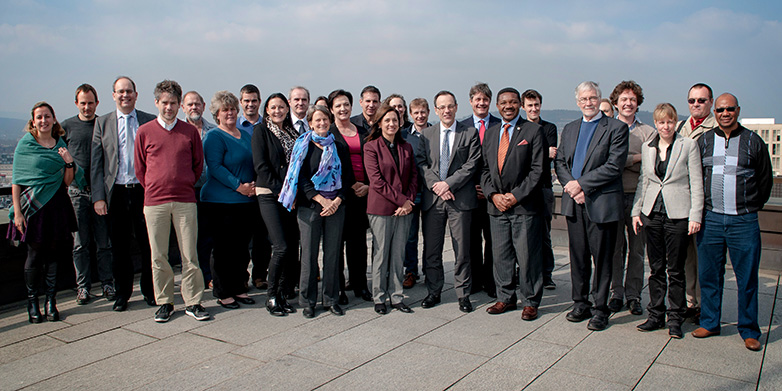“In collaborative work like this, trust and respect are essential.”
On 10 and 11 March, a delegation of board members and researchers from South Africa visited ETH Zurich. ETH News spoke to two researchers who have been working together for more than 10 years: Jens Kossmann, Director of the Institute for Plant Biotechnology at Stellenbosch University, and Samuel Zeeman, Head of the Group of Plant Biochemistry at ETH Zurich, explain what goes into making a collaboration across 10,000 km successful.

Mr Kossmann, Mr Zeeman, before we delve into your collaboration, could you briefly explain what the research itself deals with?
Zeeman: Above all, I’m interested in how plants convert carbon dioxide into starch and sugar. We’re trying to better understand the metabolism and biochemical processes of plants, so that we can optimise them – for example, in harvesting crops.
Kossmann: I began my career in the 1990s at the Max Planck Institute in Potsdam, researching starch biosynthesis. I worked mainly with the potato, because at the time it was the best model system and is still seen in Europe as the most important plant for the extraction of starch. Nowadays I also research sugar cane, in which we’re attempting to increase the sugar content. My collaboration with Sam and ETH Zurich is strongly grounded in our shared interest in a better understanding of starch biosynthesis.
How did you meet and when did you decide to work together?
Kossmann: We first met in Potsdam, while Sam was still working as a doctoral student in England. One of my then colleagues invited him to a seminar. We found that we had shared research interests and from then on we would see each other regularly at meetings for European research projects. In 2004 I moved to Stellenbosch University, near Cape Town in South Africa. From the start, I made the effort to keep up my research collaborations with European colleagues.
Why was that important to you?
Kossmann: Access to high-end technology is not always available in South Africa – for example, in the fields of mass spectronomy or in serial analysis of gene expression. Collaborating with colleagues at European universities allows me to keep our research up to date with the latest technologies.
Zeeman: At the beginning of my career, Jens was a role model for me, because of his creative approach and practical orientation. I was pleased we could continue our collaboration after he left Europe. To this day, we use our individual skills to create synergies, rather than duplicating research; for example, by working on a publication together, instead of competing with two similar publications.
How hard is it to finance this kind of collaborative research project?
Kossmann: In 2006, the University of Basel started a programme to support Swiss-South African research. That was our chance to work on a shared project. The programme later became the Swiss National Science Foundation’s Swiss-South African Joint Research Programme (see boxes), through which our research is still financed today. Unlike many European research programmes, it covers more than just travel costs. One of the fundamental problems with implementation of these kinds of bilateral research collaborations, in my opinion, is that although they are viewed favourably, and even committed to in agreements between universities, the necessary financial backing is still lacking.
Zeeman: I agree with Jens on that. Supporting mobility is certainly important, so that researchers can meet and find out where their mutual research interests lie. But beyond that, funding schemes for doctoral and post-doctoral work are also necessary.
Is it harder for researchers in South Africa to obtain these subsidies than it is for researchers in Europe?
Kossmann: I worked for a long time in Germany and have a good network of contacts in Europe. I know people, and I know who I can contact for which collaboration. But my younger colleagues in Cape Town don’t yet have these contacts in Europe. For them, things are significantly harder. That’s why these bilateral research programmes are an excellent opportunity for them – they open up a new network. I’ve sent a series of doctoral students to Europe over the past few years, and a former doctoral student from our group is working at Sam’s lab in Zurich at the moment.
Exactly what sort of form does a collaboration 10,000 km apart take? Do you visit each other regularly or do you communicate solely by telephone and email?
Kossmann: We meet at least once a year in Switzerland or South Africa. Sam has visited me three times at Stellenbosch, sometimes as part of a conference.
Zeeman: Of course, we keep in touch mostly by phone and email. It's important, though, to meet in person from time to time, to discuss the research and get to know the people at the lab.
You now have almost 10 years of experience in transcontinental research collaboration. What are the key success factors in such a project?
Zeeman: Respect and trust are essential. You have to establish shared expectations from the start and define precisely what both partners will contribute to the research.
Fears are often voiced – especially in the context of north-south collaboration – that research partners from southern countries are structurally disadvantaged, and do not benefit adequately from research collaborations. Do you also see this as a danger?
Zeeman: This was widely discussed during the South African delegation’s visit to ETH Zurich (see boxes). Fear of unequal partnerships does exist. It must be taken seriously and steps should be taken right at the start to ensure there are no inequalities. Back when we were applying for the SNSF funding, Jens and I worked out very precisely the principles of a good collaboration.
Kossmann: It's not a problem in our collaboration. I’m convinced that the majority of research collaborations between Europe and Africa are very productive for both parties – on the condition, of course, that both sides respect each other. Sam and I have been colleagues and also good friends for years, and that certainly helps.
Research collaboration between ETH Zurich and South Africa
Since 2008, South Africa has been one of the seven non-European countries with which Switzerland has developed its research collaboration through targeted programmes. In 2014, ETH Zurich signed a ‘Memorandum of Understanding’ with the University of Stellenbosch, followed by one with the University of Cape Town in 2015. These are intended to support research partnerships and define areas of possible collaboration. On 10 and 11 March 2016, a delegation of 17 academics and board members from the two partner universities, the University of Pretoria and the University of Witwatersrand visited ETH Zurich. They were welcomed by the ETH president, discussed the opportunities and challenges of bilateral research cooperation, and were introduced to a number of different research programmes as part of a workshop. The occasion also provided the researchers from the different universities with the opportunity to get to know each other better and exchange ideas on shared projects.
SNSF funding schemes for Swiss-South African research
As part of the external pageSwiss-South African Joint Research Programmecall_made (SSAJRP), the Swiss National Science Foundation (SNSF), together with its sister organisation in South Africa, the National Research Foundation (NRF), has launched a further call for collaborative research projects. 12 projects are due to be funded over a period of four years. The call for proposals runs until 31 May 2016.


